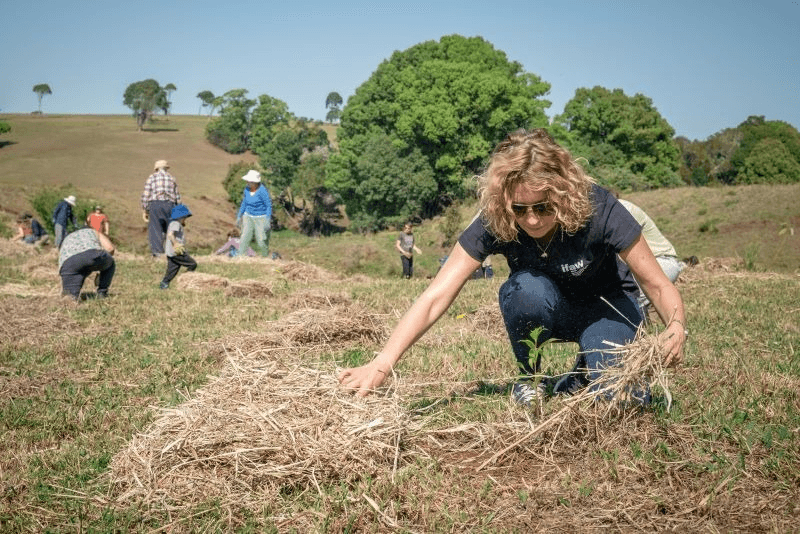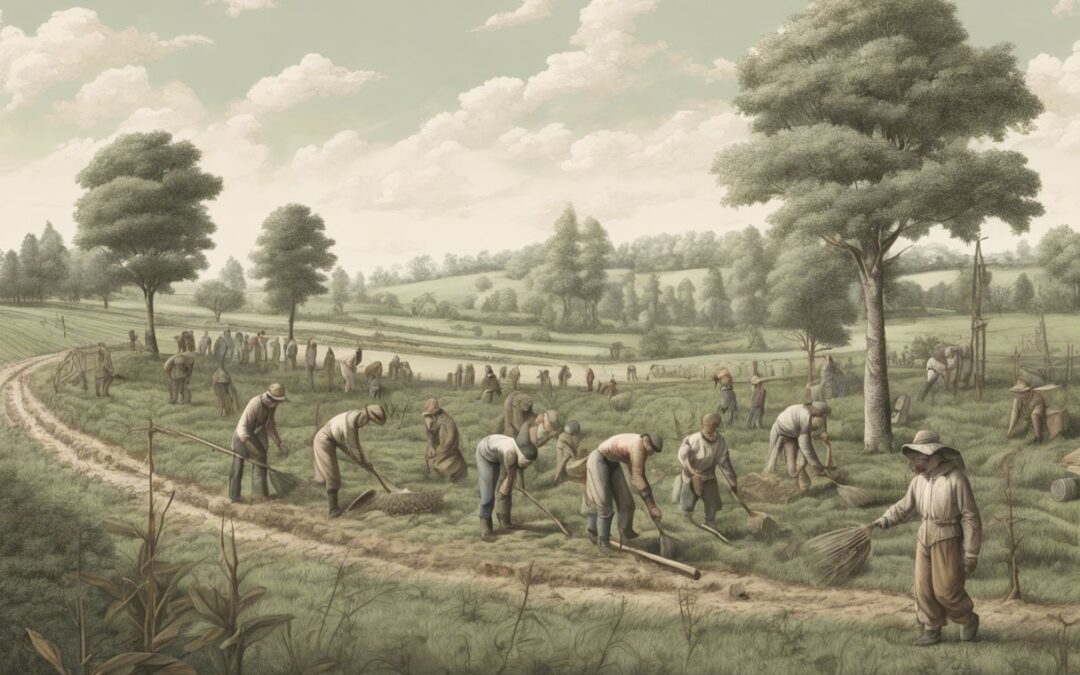Afforestation has become quite the buzzword in recent decades. What is it and why does it matter? Join The Working Forest as we uncover the world of afforestation and its significant impact on our planet’s well-being.
What is Afforestation?
Afforestation, simply put, is the process of planting trees in barren or deforested areas to improve wetlands, shelterbelts, and soil science.
Afforestation aims to create new forest cover, increase greenery, enhance soil fertility in wetlands, prevent soil erosion in land cover, and establish sustainable ecosystems that support diverse plant and animal life in shelterbelts area.
Types of Afforestation
Urban afforestation focuses on planting trees in cities and urban areas for environmental benefits. In cities, where there are often more buildings than green spaces, people are actively working to promote forestation by planting trees. Urban afforestation has several advantages. Firstly, the forest helps to improve air quality by absorbing pollutants and releasing oxygen. Secondly, urban afforestation provides shade and reduces the “heat island effect” caused by concrete and asphalt surfaces, making cities cooler and more comfortable for residents. Lastly, it creates habitats for birds and other wildlife in the forest, bringing nature closer to our daily lives.
Rural afforestation aims to create forests in rural landscapes for economic, social, and ecological purposes. In rural areas where there may be less tree cover due to deforestation or land use practices such as agriculture or logging, rural afforestation plays a crucial role in restoring tree cover. Economically speaking, it can provide a source of income through sustainable forestry practices such as timber production or non-timber forest products like fruits or nuts. Socially speaking, the forest can enhance the well-being of local communities by providing recreational spaces for outdoor activities like hiking or picnicking in the forest.
Industrial afforestation involves tree planting around industries to mitigate pollution and provide shade. Industries often emit pollutants into the air, water, and forest during their operations which can have detrimental effects on the environment, surrounding communities, and forest. The forest shade provided by trees can help lower temperatures around industrial areas, making them more comfortable for workers and reducing the need for excessive air conditioning.
Afforestation vs. Reforestation
Afforestation and reforestation are two important practices that contribute to increasing forest cover and restoring ecosystem services. While they share a common goal of planting trees in the forest, there are distinct differences between the two.
Afforestation Creates New Forests
Afforestation involves the establishment of forests on non-forest land. It is the process of converting barren or non-vegetated areas into thriving forests by planting trees.
Reforestation Restores Damaged Forests
Reforestation, on the other hand, focuses on replanting trees in areas that were previously forested but have been cleared or damaged. The primary objective of reforestation is to restore specific forest types that have been lost due to logging, wildfires, or other disturbances. It involves regenerating natural forests through planting new trees or allowing natural regeneration processes to occur.
Considerations for Successful Implementation
To ensure successful afforestation and reforestation projects, several factors should be considered:
Suitable Tree Species: Selecting tree species that are well-suited to the local climate, soil conditions, and ecosystem is essential for long-term success.
Land Use Planning: Proper land use planning is crucial to identify suitable areas for afforestation or reforestation projects without encroaching on agricultural land or sensitive habitats.
Community Involvement: Engaging local communities and stakeholders in the decision-making process fosters ownership, enhances project sustainability, and promotes social benefits.
- Monitoring and Maintenance: Regular monitoring and maintenance of newly planted trees are necessary to ensure their survival and growth.
Benefits of Afforestation
Afforestation serves several important purposes that have a positive impact on the environment and society. Let’s explore these purposes in more detail:
Increasing Green Cover
One of the main goals of afforestation is to increase the green cover in areas where wetlands and shelterbelts have been depleted. This helps with soil science and the reduction of CO2 emissions. When trees are planted on barren land as part of an afforestation project, they gradually grow and form a new forested area. This process helps in the creation of wetlands and shelterbelts, while also contributing to the reduction of carbon emissions. This not only beautifies the wetlands and forest area, but also provides numerous benefits such as forest cover and forestation.
Enhancing Soil Fertility
Afforestation efforts play a crucial role in enhancing soil fertility by sequestering carbon dioxide (CO2) and increasing carbon levels in the soil. When trees are planted, their roots penetrate deep into the ground, aiding in forestation and holding the soil together to prevent erosion caused by wind or water. The fallen leaves from these trees act as natural mulch, enriching the soil with organic matter over time. When the organic matter decomposes, it releases essential nutrients into the soil, promoting forestation and enhancing carbon sequestration.
Preventing Soil Erosion
Soil erosion occurs when topsoil is washed away due to heavy rainfall or blown away by strong winds. Afforestation helps combat the issue of excessive carbon dioxide (CO2) emissions by providing a protective layer of vegetation that acts as a barrier against erosive forces. The roots of trees help with forestation by binding the soil particles together, reducing runoff and preventing valuable topsoil from being lost. As a result, areas that undergo forestation, or afforestation, experience reduced erosion rates and maintain their agricultural productivity.
Supporting Biodiversity
Afforestation programs significantly contribute to supporting biodiversity by creating habitats for various plant and animal species. Forestation in carbon-rich areas provide shelter, food sources, and breeding grounds for a wide range of organisms and support the survival of numerous species, including birds, mammals, insects, and microorganisms. By increasing forest area through afforestation efforts, we can help conserve biodiversity and protect endangered species.
Provides habitat for wildlife
One of the key benefits of afforestation is that it creates new habitats for wildlife. When trees are planted, they provide shelter, food sources, and nesting sites for various species of animals and birds. including endangered or vulnerable species. Afforestation helps to restore balance to ecosystems that may have been disrupted due to deforestation or other human activities.
Timber Production
Apart from its environmental advantages, afforestation also brings economic benefits to communities. One significant advantage is timber production. As trees mature, they can be harvested sustainably for timber, which can be used in construction, furniture-making, and other industries. This not only provides a renewable source of raw material but also generates income and employment opportunities.
Ecotourism
Afforested areas can become hotspots for ecotourism. People are drawn to these green spaces because they offer recreational activities such as hiking trails or birdwatching opportunities. Ecotourism can contribute significantly to local economies by attracting visitors who spend money on accommodations, meals, and other services.
Improved Air Quality
One of the significant benefits of afforestation is its ability to improve air quality. As new forests are planted, they act as natural filters by absorbing pollutants from the air and releasing oxygen through photosynthesis.
Enhanced Water Quality
Forests play a crucial role in maintaining water quality. Afforested areas act as natural water filters by reducing sedimentation and filtering contaminants from runoff before it reaches rivers and streams. The trees’ roots help prevent soil erosion, ensuring that less sediment enters water bodies.
Climate Change Mitigation
Afforestation plays a crucial role in mitigating climate change effects by acting as carbon sinks. Through photosynthesis, trees absorb carbon dioxide (a greenhouse gas) from the atmosphere and store it within their biomass.
Provision of Ecosystem Services
Forests help regulate water cycles, prevent soil erosion, and support nutrient cycling. They also offer recreational opportunities such as hiking and wildlife observation. Moreover, forests contribute to the economy through timber production and tourism, making them valuable assets for local communities.
Prevention of Desertification and Land Degradation
Another essential benefit of afforestation is its role in preventing desertification and land degradation. When areas are deforested or left barren, soil erosion can occur due to wind or water action, leading to loss of fertile topsoil. Afforestation helps combat this issue by stabilizing soil with tree roots, preventing erosion and preserving soil fertility. This fertile land can then be used for agricultural purposes, ensuring food security for communities.
Enhancement of Aesthetic Value
Afforestation also enhances the aesthetic value of landscapes by adding greenery and biodiversity. Planting trees not only beautifies our surroundings but also creates recreational spaces for communities to enjoy nature. Parks filled with lush green trees provide a peaceful escape from urban environments, allowing people to relax, exercise, and connect with nature.

Afforestation Techniques
Direct Seeding
Direct seeding is a technique used in afforestation activities where tree seeds are sown directly into the ground without raising seedlings in nurseries. This method eliminates the need for transplanting and reduces costs associated with growing seedlings. By scattering seeds across the land, native trees can be established, contributing to an increase in forestation initiatives.
Planting Saplings or Seedlings
Another common technique for afforestation is planting saplings or seedlings. This method ensures higher survival rates and faster establishment of forests compared to direct seeding. By transplanting young trees into the desired areas, it allows for better control over their growth and development. The use of saplings or seedlings also enables afforestation efforts to scale up more effectively as they can be easily transported and planted across various locations.
Agroforestry
Agroforestry combines tree planting with agricultural practices, creating a mutually beneficial relationship between them. This technique integrates trees into agricultural sites, providing multiple benefits such as improved crop yields and increased biodiversity. The presence of trees in agroforestry systems helps reduce soil erosion, enhance water retention, and provide shade for crops. The trees contribute to carbon sequestration by absorbing atmospheric carbon dioxide.
Commercial Plantations
Commercial plantations involve planting specific tree species on a large scale for economic purposes such as timber production or other commercial uses. These plantations are carefully managed to optimize growth and yield of the selected species. While commercial plantations may not offer the same level of biodiversity as natural forests, they play a crucial role in meeting global demand for wood products while reducing pressure on natural forests.
Shelterbelts
Shelterbelts are rows of trees planted along field edges or boundaries to protect crops from wind erosion and create microclimates that benefit agriculture. They act as barriers against strong winds, reducing evaporation rates and preventing soil degradation. Shelterbelts also enhance landscape aesthetics and provide habitat for wildlife, contributing to biodiversity conservation.
Green Walls
Green walls, also known as vertical gardens or living walls, are innovative techniques used in urban areas to maximize limited space for afforestation. These structures consist of plants grown vertically on building facades or other vertical surfaces. Green walls not only improve air quality by absorbing pollutants but also provide insulation, reducing energy consumption in buildings.
Get involved.
To further support afforestation efforts, individuals can participate in tree planting initiatives or support organizations that focus on reforestation projects. Governments can implement policies that incentivize afforestation and provide funding for sustainable forestry practices. It is also important to raise awareness about the benefits of afforestation and educate communities on the importance of preserving forests.
FAQs
What is afforestation?
Afforestation refers to the process of establishing a forest, or stand of trees, in an area where there was no forest. It involves planting trees in areas that have experienced deforestation or have been devoid of tree cover for various reasons.
How does afforestation benefit the environment?
It helps prevent soil erosion by stabilizing the soil with tree roots. Trees also act as natural filters, purifying air by absorbing pollutants and releasing oxygen. Afforested areas contribute to water conservation as trees help regulate water cycles and reduce runoff.
